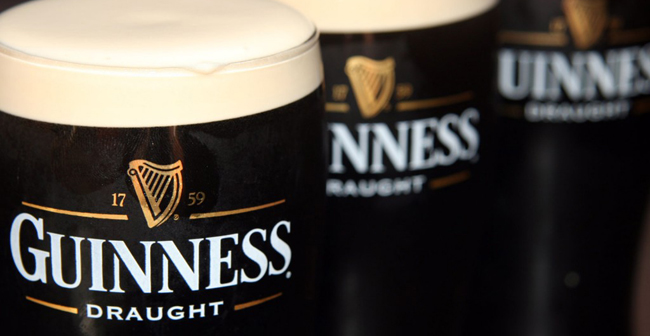Eat

Guinness And…
March 1, 2013 @ 12:00am
Guinness is the quintessential Irish beer, but it is also a perfect beer to mix with almost any other beer, or even liquor for that matter. Guinness has unique chemical properties that allow it to float atop other carbonated beverages. If you didn’t like chemistry in high school – you will now. Different from other dark beers, Guinness is made with nitrogen, which is less dense than carbonation used in beers such as Harp or Blue Moon. This differences in density allows the beers to layer on top of one another. If poured gently with a spoon or flat surfaced bar tool, the Guinness should float on top while your other beer is on the bottom. Now wouldn’t chemistry class have been a lot more fun if you were balancing Guinness and cider rather than chemical equations? So try experimenting with these mixable beverages and decide for yourself, which is your favorite?
Black and Tan
The original combo – where it all began. Commonly mixed with Harp or Bass, the Black and Tan originated in Britain and his since become popular in the U.S. However, be careful not to offend the Irish with the name “Black and Tan,” as it is also a phrase referring to a reserve force known for attacking Irish civilians in the 1920’s. If you are ever in Ireland or at an Irish bar, just order a “Half and Half.”
Black and Blue (Blue Moon)
The velvety taste of Guinness mixed with the popular citrusy flavor of Blue Moon, is a match made in heaven. Once you sip through the layer of Guinness, followed by the delicious orangey flavor you’ll find a drinker perfect for those who enjoy a bit of sweetness with their beer.
Blackcastle (Newcastle)
Is mixing two dark beers weird? Not at all! Newcastle, with a caramel, nutty aroma and roasty malt taste reduces the bitterness of the Guinness while still maintaining hints of it’s original flavor. The carbonation of the Newcastle creates an enjoyable balance between the two similar yet opposite beers.
Belgian Brunette (Stella)
The crispness of the Stella intertwines with the dark, full-body of Guinness in such a way that the Guinness takes on some of the lighter beer’s effervescence. The bitterness of Stella is reduced by the Guinness, leaving the imbiber with a slight after experience of citrus and hops. As with the other lighter blends on the list, the Stella also expands the Guinness and gives it a cheery, weightless texture on the palate.
Midnight in the Garden (Hoegaarden)
Best to enjoy on a summer day, Hoegaarden has an aroma of lemon and banana flavor that can perk up your Guinness a bit. Midnight in the Garden mixes Guinness with the much lighter Hoegaarden. Adds a hint of citrus and brightens up the Guinness, highlighting the chocolate notes.
The Chocolate Covered Cherry (Sam Adam’s Cherry Wheat)
Pretty much exactly how it sounds – the sweet fruity delicious flavor from the cherry wheat beer blends perfectly, bringing out the chocolate accents from the Guinness. Imagine a cherry chocolate pie, only with a hint of bitterness, and in a glass. And if you want to really go crazy, you can throw some cherries on top.
Black and Smooth (Kilkenny)
Kilkenny, originating in Irleland, is a red ale cream brew made with malted barley, hops, and yeast. Just like the science behind the creation of Guinness, Kilkenny is also a nitrogenated beer. Known for the aroma of warm bread, it is sure to add a toasty flavor to the combo.
Black Velvet (Champagne)
For a classy, luxurious version try adding Champagne to your Guinness. The bubbling champagne calms the Guinness bitterness and makes the mocha flavors stand out. Sweetness, plus bubbliness, clashing into the dark nitronated stout – ta-dah, you’ve got the Black Velvet.
Black Veleveteen or Snakebite (Cider)
The sweetness of hard cider compliments the Guinness. Expect sweet layers of flavor. What’s fun about the Veleveteen is that you can get creative by trying different flavors of cider.
BLACKSMITH (Smithwicks & Guinness)
Instead of trying to remove the bitterness from the Guinness, for those who enjoy the darker beers, add Smithwick’s to make both beers intensify each other. You won’t lose the Guinness flavor and you’ll add the maltiness and caramel aroma of Smithwick’s.








